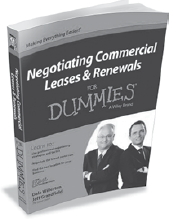Negotiating The Area (Or Square Footage) Of Your Commercial Property
 Choosing space for your business means more than choosing the right location. Finding the right amount of square footage in the right configuration is also a big part of your decision-making process when setting up a business. To know what works best for you, you’ll need an understanding of how landlords measure space and what your space requirements are.
Choosing space for your business means more than choosing the right location. Finding the right amount of square footage in the right configuration is also a big part of your decision-making process when setting up a business. To know what works best for you, you’ll need an understanding of how landlords measure space and what your space requirements are.
When it comes to initially choosing the right amount of area to lease for your business, you’ll need to consider several factors, including the following:
Landlords traditionally lease space based on a square footage basis. This is neither good nor bad; it’s simply the industry standard. As a tenant, this means you can’t always choose or control the exact amount of space you are able to lease because landlords create independent commercial retail units (CRUs) that are pre-set in size.
The amount of area you need now could change in a few years. Many tenants outgrow their current location as they expand. If you have joined a franchise system, this will happen less frequently as franchise tenants work from a predetermined, cookie-cutter formula that determines their success.
Choosing the right commercial space is imperative to your success; however, it’s also important that you get the space you pay for. When an area isn’t measured correctly, you can end up with phantom space – or space that really isn’t there even though you’re being charged rent for it. While most of the phantom space cases we investigate are accidental or negligent (rather than fraudulent), as a tenant, you still pay the price of the mistake. If you discover that your area has been wrongly measured or miscalculated, you need to take action immediately! Although many landlords may agree to an obvious measurement discrepancy for the future, they can be resistant about paying the tenant back for past years of rent overcharges.
One quick way to measure rooms or a space – counting ceiling tiles – requires few tools and little effort. Although counting ceiling tiles is unscientific and imprecise, it can help you get a feel for the size of various rooms, areas, and/or offices. Another good idea is taping off the floor where you think walls should be built. This is an extremely useful exercise. Once you’ve taped off the individual rooms to your required sizes, you can better determine whether the space is adequate for your needs.
A common mistake tenants make when considering how much space to lease is not factoring in useable vs. rentable space. Useable space is just that – space you can actually utilize within the space to place merchandise or fixtures. Rental space factors in the thickness of the walls – space which cannot be used to your benefit but for which tenants typically pay rent. As previously noted, counting ceiling tiles gives you a rough estimate of the useable space but not the actual rentable space.
When it comes to evaluating the area of a commercial space, another related term to understand is frontage – this is the magic word for retail tenants. Frontage is the exposed area of fascia and windows that prospective customers walking or driving by can see from the parking lot or road – most retail tenants want as much frontage as they can get!
Some CRUs are irregular in shape, but most lease spaces are generally rectangles. If a plaza is 100 feet in depth and the tenant wants only 1,000 square feet, this means that the tenant has just 10 linear feet of frontage (not nearly enough to make shoppers comfortable). Sure, the space is rectangular, but it’s more like a bowling lane. As customers, we don’t want to walk to the back of long, narrow shops/stores. In this case, the retail tenant will have merchandizing challenges as well.
Once you have selected your commercial space, you may want to contact a professional space planner. Good space planners are worth their weight in gold; you can find substantial cost savings with respect to washrooms, doorways and hallways if they’re well thought out. Often a space planner can help factor in columns, irregular corners, or protrusions to maximize functional use of the space available.
For a copy of our free CD, Leasing Do’s & Don’ts for Commercial Tenants, please e-mail your request to DaleWillerton@TheLeaseCoach.com.
Dale Willerton and Jeff Grandfield - The Lease Coach are Commercial Lease Consultants who work exclusively for tenants. Dale and Jeff are professional speakers and co-authors of Negotiating Commercial Leases & Renewals For Dummies (Wiley, 2013).
1-800-738-9202
e-mail DaleWillerton@TheLeaseCoach.com or visit www.TheLeaseCoach.com.

